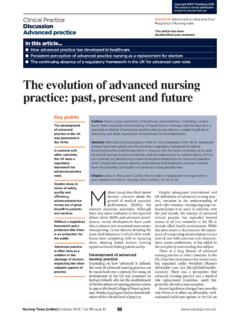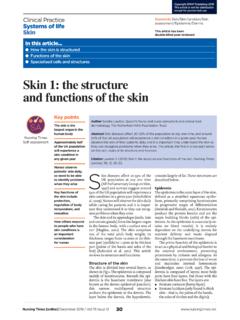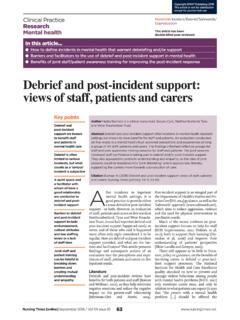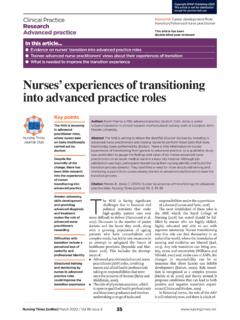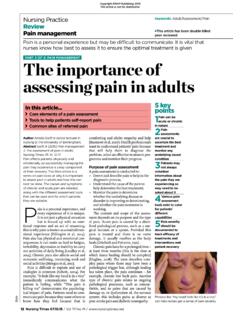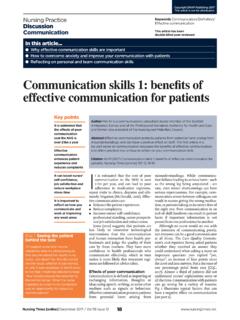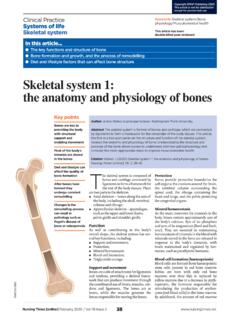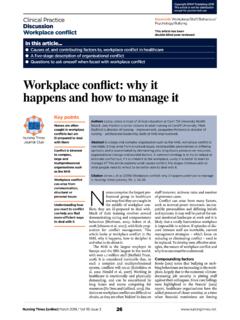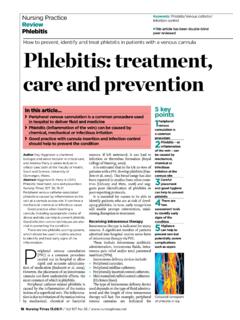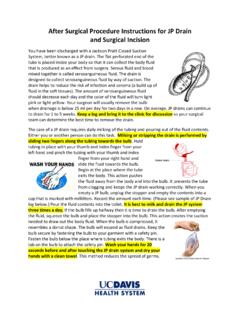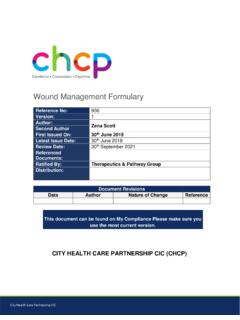Transcription of PEG tubes: dealing with complications - EMAP
1 18 Nursing Times / Vol 110 No 45 / PracticeReviewNutritionKeywords: Percutaneous endoscopic gastrostomy/ complications /Granulation This article has been double-blind peer reviewedAuthors Hardip Malhi and Rosie Thompson are nutrition nurse specialists; both at the University Hospitals Birmingham Foundation Malhi H, Thompson R (2014) PEG tubes: dealing with complications . Nursing Times; 110: 45, 18-21. A percutaneous endoscopic gastronomy tube can be used to deliver nutrition, hydration and medicines directly into the patient s stomach. Patients will require a tube if they are unable to swallow safely, putting them at risk of aspiration of food, drink and medicines into their lungs. It is vital that nurses are aware of the complications that may arise when caring for a patient with a PEG tube.
2 It is equally important that nurses know how to deal with these complications or from where to seek advice. This article provides a quick troubleshooting guide to help nurses deal with complications that can arise with PEG feeding. In March 2010, the National Patient Safety Agency issued a rapid response report on the early detection of compli-cations after inserting a percutaneous endoscopic gastrostomy tube (PEG). Between October 2003 until January 2010 the NPSA received 11 reports of death and 11 reports of severe harm relating to PEG tubes (NPSA, 2010). The NHS Litigation Authority received 23 claims between October 2003 and January 2010, of which seven were related to patient deaths (NPSA, 2010).
3 These reports identified that red flag symptoms (Table 1) were not recognised, and there were delays in recognising com-plications in the first 72 hours after gastros-tomy insertion. A case study in Box 1 illus-trates the importance of correct insertion. 5 key points 1 People with percutaneous endoscopic gastrostomy tubes can be in hospital or living at home2 PEG insertion is carried out when the patient is sedated, not under a general anaesthetic3 complications that can occur include infection and tube blockage4 Patients and carers must be taught how to care for the PEG and keep the insertion site clean5 Patients should be told who to contact should complications occur after dischargeThe National Institute for Health and Care Excellence (2006) has recommended that the multidisciplinary healthcare team provides patients and carers with training to manage their own PEGs.
4 Occasionally some patients are unable to do this, for example, during times of illness that require hospital admission or immediately after a tube is inserted. It is vital that nurses managing these tubes are able to recognise and manage complications and know how to get assistance. What is a PEG and who needs one?A PEG delivers nutrition, hydration and medicines directly into the patient s stomach (Fig 1). PEG stands for: Percutaneous inserted through the skin; Endoscopic the procedure used to insert the tube; Gastrostomy the opening into the stomach from the abdomen. PEG tubes are needed by patients who In this Description of PEG tubes and who needs them complications that can arise after PEG insertion How to manage complicationsComplications arising from the insertion of percutaneous endoscopic gastrostomy tubes can be life-threatening so nurses should be able to identify and manage them PEG tubes: dealing with complications The patient remained an inpatient for two days after PEG [percutaneous endoscopic gastronomy tube] insertion, but was discharged despite abdominal pain and leakage of gastric contents from the gastrostomy site.
5 They were re-admitted four days later and internal leakage was confirmed. Despite corrective surgery and ITU [intensive therapy unit] care they died three weeks later. Source: National Patient Safety Agency (2010)Box 1. CAsE sTuDy: THE DEATH of AN ADulT PosT PEG iNsErTioNCatherine Hollick adapted from picture courtesy of University Hospitals Birmingham Foundation TrustExternal fixation plateStomachInternal bumperAbdomenFIg 1. PEG PlACEmENT / Vol 110 No 45 / Nursing Times 19have difficulty swallowing, placing them at risk of aspirating food and fluids into the lungs. At-risk groups include patients who have had a stroke or neurological trauma (head injuries) or those who have long-term neurological conditions such as multiple sclerosis and motor neurone dis-ease.
6 These patients are likely to need a PEG for the long term. Patients who have cancer of the head or neck may require PEGs in the short term while they are having treatment, as swallowing is likely to be temporarily affected. In 2010, 3,430 patients living in the UK were registered with the British Artificial Nutrition Survey as receiving home enteral feeding (BANS, 2011). Of these, 75% were fed via a PEG tube. Most of the patients (63%) were over 60 years old and 41% were aged over 70 years (BANS, 2011). This age profile suggests these patients are more likely to require some level of assistance. PEG insertionPEG insertions are usually carried out in an endoscopy department with the patient under sedation rather than under a general anaesthetic.
7 An endoscope (camera) is passed through the patient s mouth and into the stomach. The stomach is inflated with air to improve visibility and the infla-tion moves the stomach wall closer to the anterior abdominal wall. When the endo-scope is in the stomach the light at the end of it shines through the skin; at this point, the lights in the room are dimmed so the endoscopy light can be detected through the abdomen and used to help identify the position of the stomach. Local anaesthetic is administered into the insertion site, then a small incision is made, into which a cannula is inserted; through this, a wire is passed into the stomach. Forceps are inserted through the endo-scope to grab the wire and, as the endo-scope is removed, the wire is also brought out of the patient s mouth.
8 The PEG is attached to this wire then pulled from the stomach end, moving the tube down the oesophagus and out through the incision made in the stomach. The tube is held in the stomach by an internal retention disc, commonly known as an internal bumper. An external fixation plate, clamp and con-nector are then fitted onto the tube to ensure the PEG is secure (Fig 1). safety concerns The NPSA strongly recommends using a high-visibility warning label on procedure reports and/or in medical notes to identify potential issues that may arise after gastros-tomy insertion (Fig 2). It also recommends that systemic observations including blood pressure, pulse, temperature and oxygen saturations be carried out regularly and according to local policy after PEG insertion to detect signs of deterioration.
9 If complications are identified, feeding and medication delivery down the tube should be stopped immediately and advice sought from the medical team responsible for the patient s care. If complications occur after discharge, patients should be advised to attend their local accident and emergency department immediately. Patients discharged within 72 hours of PEG insertion must be made aware of the red flag complications and be given con-tact numbers for local out-of-hours ser-vices they can call for urgent advice (NPSA, 2010). Patients discharged 72 hours or more after insertion are advised on who to contact for advice if they experience any problems. This could be the medical team, nutrition nurse or dietitian, depending on the services available at their local hos-pital.
10 Patients should be given the relevant contact details on discharge, and advised to attend their local accident and emer-gency department if the feel the situation is of pain, leakage of some gas-tric fluid around the PEG tube, and bleeding after PEG insertion are all normal and expected; it is the severity of the symp-toms that determine whether medical intervention is needed. It is important for patients and nurses to know who to contact if they are unsure, and to be aware of the difference between what is normal and abnormal. Normally a small amount of leakage can be expected to last for a few days after insertion but this should not be excessive (not requiring a dressing change more than twice a day) and should stop by itself.
